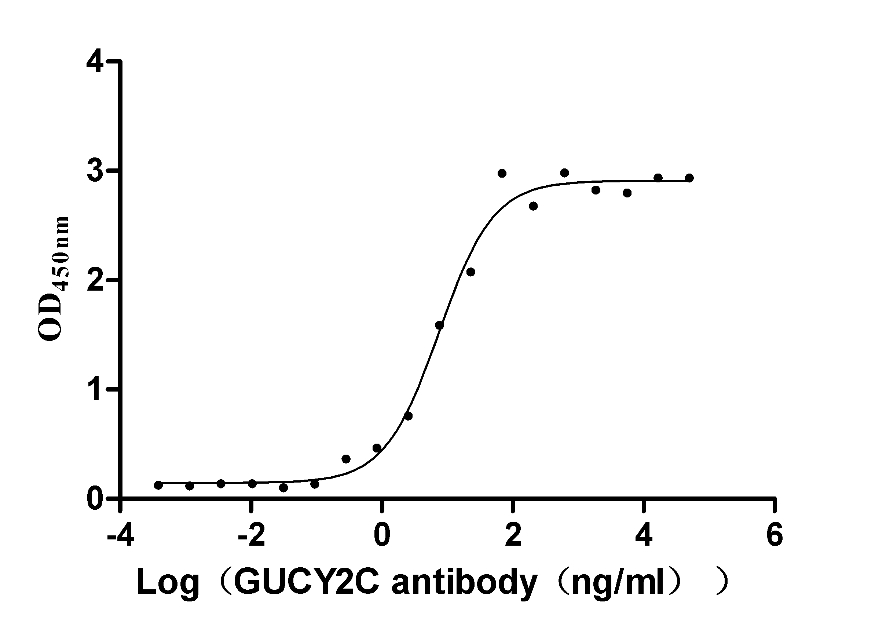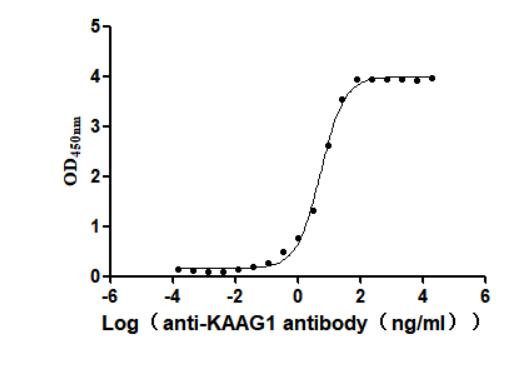Recombinant Mouse BH3-interacting domain death agonist (Bid)
-
货号:CSB-YP002698MO
-
规格:
-
来源:Yeast
-
其他:
-
货号:CSB-EP002698MO
-
规格:
-
来源:E.coli
-
其他:
-
货号:CSB-EP002698MO-B
-
规格:
-
来源:E.coli
-
共轭:Avi-tag Biotinylated
E. coli biotin ligase (BirA) is highly specific in covalently attaching biotin to the 15 amino acid AviTag peptide. This recombinant protein was biotinylated in vivo by AviTag-BirA technology, which method is BriA catalyzes amide linkage between the biotin and the specific lysine of the AviTag.
-
其他:
-
货号:CSB-BP002698MO
-
规格:
-
来源:Baculovirus
-
其他:
-
货号:CSB-MP002698MO
-
规格:
-
来源:Mammalian cell
-
其他:
产品详情
-
纯度:>85% (SDS-PAGE)
-
基因名:
-
Uniprot No.:
-
别名:BidBH3-interacting domain death agonist; p22 BID; BID) [Cleaved into: BH3-interacting domain death agonist p15; p15 BID); BH3-interacting domain death agonist p13; p13 BID); BH3-interacting domain death agonist p11; p11 BID)]
-
种属:Mus musculus (Mouse)
-
蛋白长度:Full length protein
-
表达区域:1-195
-
氨基酸序列MDSEVSNGSG LGAEHITDLL VFGFLQSSGC TRQELEVLGR ELPVQAYWEA DLEDELQTDG SQASRSFNQG RIEPDSESQE EIIHNIARHL AQIGDEMDHN IQPTLVRQLA AQFMNGSLSE EDKRNCLAKA LDEVKTAFPR DMENDKAMLI MTMLLAKKVA SHAPSLLRDV FHTTVNFINQ NLFSYVRNLV RNEMD
-
蛋白标签:Tag type will be determined during the manufacturing process.
The tag type will be determined during production process. If you have specified tag type, please tell us and we will develop the specified tag preferentially. -
产品提供形式:Lyophilized powder
Note: We will preferentially ship the format that we have in stock, however, if you have any special requirement for the format, please remark your requirement when placing the order, we will prepare according to your demand. -
复溶:We recommend that this vial be briefly centrifuged prior to opening to bring the contents to the bottom. Please reconstitute protein in deionized sterile water to a concentration of 0.1-1.0 mg/mL.We recommend to add 5-50% of glycerol (final concentration) and aliquot for long-term storage at -20℃/-80℃. Our default final concentration of glycerol is 50%. Customers could use it as reference.
-
储存条件:Store at -20°C/-80°C upon receipt, aliquoting is necessary for mutiple use. Avoid repeated freeze-thaw cycles.
-
保质期:The shelf life is related to many factors, storage state, buffer ingredients, storage temperature and the stability of the protein itself.
Generally, the shelf life of liquid form is 6 months at -20°C/-80°C. The shelf life of lyophilized form is 12 months at -20°C/-80°C. -
货期:Delivery time may differ from different purchasing way or location, please kindly consult your local distributors for specific delivery time.Note: All of our proteins are default shipped with normal blue ice packs, if you request to ship with dry ice, please communicate with us in advance and extra fees will be charged.
-
注意事项:Repeated freezing and thawing is not recommended. Store working aliquots at 4°C for up to one week.
-
Datasheet :Please contact us to get it.
靶点详情
-
功能:Induces caspases and apoptosis. Counters the protective effect of BCL2.; Induces caspase activation and apoptosis. Allows the release of cytochrome c.
-
基因功能参考文献:
- we show that BID is an important regulator downstream of FAS in mouse neutrophils. Loss of BID significantly delays FASL-cell death and partially counteracts the switch from apoptosis to necroptosis when caspases are blocked. PMID: 29495595
- Study exposes BID as the molecular link between the previously separated pathways of oxidative stress signaling by merging the death pathways of ferroptosis and oxytosis at the level of mitochondria, i.e. the crucial point of decision for neuronal function and survival. PMID: 28384611
- Cleaved Bid did not permeabilize the membrane, but lowered the membrane breakthrough force. PMID: 27755971
- toxic reactive oxygen species levels in Mll5(-/-) mice are critically dependent on type 1 interferon (IFN-1) signaling, which triggers mitochondrial accumulation of full-length Bid. PMID: 27641306
- In the present study, we identified the proapoptotic Bcl-2 family protein Bid as a positive regulator of mutant SOD1-induced TLR-nuclear factor-kappaB (NF-kappaB) signaling in microglia. PMID: 27257617
- DRP1-dependent apoptotic mitochondrial fission occurs independently of BAX, BAK and APAF1 to amplify cell death by BID and oxidative stress. PMID: 26997499
- A phosphorylation-deficient mutant of BID, MTCH2's ligand, induces an increase in OXPHOS, but with higher ROS and reduced ATP levels than Mtch2 loss, and is associated with hypersensitivity to irradiation. PMID: 26219591
- BID protein suppresses p38 activity and induce malignant cell transformation of hepatocytes. PMID: 25951810
- important mediator of hepatic ischemia-reperfusion injury in both lean and steatotic livers PMID: 25483735
- compare membrane permeabilization by Bax activated by either cBid [cleaved Bid (p7 and p15)] or Bim and examine the role of membrane lipids in the recruitment and activation of these three Bcl-2 pro-apoptotic proteins PMID: 25714678
- Hepatocyte Bid suppression is critical for the resistance to the lethal effects of Fas activation. Fas signaling induces differential activation of non-canonical interleukin-1beta maturation, amplified in the absence of apoptotic Bid in hepatocytes. PMID: 24681344
- Data demonstrate a new role for Bid as a mediator of astrocyte activation during neuroinflammation, and suggest that Bid activation may contribute to non-cell autonomous motoneuron degeneration in amyotrophic lateral sclerosis PMID: 24956542
- BID is required for tumor suppression by NSAIDs in APCMin/+ mice. It mediates these chemopreventive effects via selective killing of APC-deficient intestinal stem cells. PMID: 25368155
- as soluble Bid progresses toward a membrane-inserted state, it undergoes an oligomerization process similar to that observed for Bax PMID: 24853737
- data demonstrate that increased thyroid expression of BID facilitates the development of autoimmune thyroiditis induced by iodine uptake. However, the overexpression of BID itself is not sufficient to initiate thyroiditis in CBA/J (H-2 k) mice PMID: 24957380
- The assessment of p53 and p21 can be expensive, but it proves to be a useful tool in difficult cases. Positive reaction to p53 can be noted in both, benign and malignant ovarian tumors PMID: 24745156
- The BH3-only proteins Bim and Bid are functionally active but are restrained by the anti-apoptotic Bcl-2 family proteins under physiological conditions. PMID: 23986435
- Ethanol-induced apoptosis of hepatocytes was mediated by Bid protein. PMID: 22273278
- Three cathepsin D-specific cleavage sites in Bid, Phe24, Trp48, and Phe183, were identified. PMID: 22964611
- The role of the BH3-only Bcl-2 family member Bid in the response of murine hematopoietic cells initiates the DNA damage response to replicative stress. PMID: 22522598
- Bid regulates both the phagocytotic activities and inflammatory profiles of microglia and macrophages; Bid deficiency does not impair lipopolysaccharide-induced signaling. PMID: 21264947
- beta-cell apoptosis in type 1 diabetes can proceed without Fas-induced killing mediated by the BH3-only protein Bid PMID: 21644000
- study demonstrates a positive impact of Bid on hematopoietic regeneration mainly due to its unique effects on donor lymphopoiesis in the transplant recipients PMID: 21703985
- Mutation of Cav-1 Y14 tyrosine to phenylalanine (Y14F) disrupted the hyperoxia-induced interaction between BID and Cav-1 and subsequently yielded a decreased level of tBID and resistance to hyperoxia-induced apoptosis. PMID: 21382479
- Through its collaboration with Bim, a role for Bid is uncovered in coordinating apoptotic signaling pathways to ensure appropriate shutdown of T cell immune responses after acute and persistent influenza virus infection. PMID: 21339359
- BID interacts with NOD1, NOD2 and the IkappaB kinase (IKK) complex, impacting NF-kappaB and extracellular signal-regulated kinase (ERK) signalling. PMID: 21552281
- Our data suggest that TNFalpha can cooperate with FasL to induce hepatocyte apoptosis by activating the BH3-only proteins Bim and Bid. PMID: 20872776
- apoptosis-inducing factor is not dependent on Bid for mitochondrial release and nuclear import PMID: 20646170
- Findings provide new insights into the mechanism of action of tBid, and particularly emphasize the importance of the interaction of the helix alphaH6 with CL for both mitochondrial targeting and pro-apoptotic activity of tBid. PMID: 20179769
- these studies provide a novel scenario of the anti-apoptotic function of Bid through the activation of the IKKbeta/NFkappaB pathway which further mediates COX-2 expression. PMID: 20088789
- Bid regulates hepatocyte proliferation by positively affecting [Ca(2+)](ER) homeostasis, and this could be important for liver regeneration and carcinogenesis. PMID: 20578150
- Bid was shown to activate Bax independently of the stoichiometric ratio, suggesting that Bid has a catalytic function and that the interaction with Bax in the formation of Bax multimers is transient PMID: 20008353
- The effects of titanium dioxide nanoparticles on cell apoptosis and the molecular mechanisms involved in this process are reported. PMID: 20077182
- cyt c release is independent of Bid or Bax/Bak. PMID: 19644510
- tBID Homooligomerizes in the mitochondrial membrane to induce apoptosis PMID: 11805084
- mitochondrial activation by Bid is required for reversing the inhibitor-of-apoptosis proteins inhibition through Smac release PMID: 12011074
- demonstrates the contribution of this specific pro-death molecule to the activation of neuronal apoptosis and ultimate cell death after cerebral ischemia PMID: 12200426
- BID is a p53-responsive 'chemosensitivity gene' that may enhance the cell death response to chemotherapy PMID: 12402042
- Mouse hepatitis virus-induced apoptosis in 17Cl-1 cells involves a mitochondria-mediated pathway and its downstream bid cleavage PMID: 12441076
- full-length BID as an active player in the mitochondria during apoptosis PMID: 12519725
- Premalignant Bid-/- myeloid precursor cells are resistant to death receptor-induced apoptosis. PMID: 12533511
- in parallel with Casp12 activation, ER stress triggers casp8 activation, resulting in cytochrome c/casp9 activation via Bid processing. PMID: 12581736
- results show that epidermal growth factor(EGF) decreases the expression of Bid protein and suggest that the effect of EGF on Bid is one of the mechanisms of the antiapoptotic effect of EGF PMID: 12702491
- identified for the first time a predominant role for the caspase-8/Bid pathway in signaling associated with hyperoxic lung injury and cell death in vivo and in vitro PMID: 12754217
- Bid-mediated apoptosis requires Bax and Bak PMID: 12808108
- Bid does not have an essential role in apoptosis caused by cathepsins in a mouse model of model of progressive myoclonus epilepsy PMID: 12934064
- Bid activates multiple mitochondrial apoptotic mechanisms in primary hepatocytes after death receptor engagement. PMID: 12949730
- Our present studies demonstrate that Hsp90 can suppress tumor necrosis factor alpha (TNFalpha)-induced apoptosis in stable Hsp90-overexpressing NIH3T3 cells by preventing the cleavage of Bid. PMID: 14687661
- Factor associated with neutral sphingomyelinase activation (FAN) is upstream of caspase-8/Bid in a signaling cascade culminating in lysosomal permeabilization. PMID: 15075251
- Bid, cleaved by an undefined aspartate-specific protease, can be a key mediator of the apoptotic response to DNA-damaging anticancer regimens PMID: 15117953
显示更多
收起更多
-
亚细胞定位:Cytoplasm. Mitochondrion membrane. Mitochondrion outer membrane.; [BH3-interacting domain death agonist p15]: Mitochondrion membrane.; [BH3-interacting domain death agonist p13]: Mitochondrion membrane.
-
数据库链接:
KEGG: mmu:12122
STRING: 10090.ENSMUSP00000004560
UniGene: Mm.235081
Most popular with customers
-
Recombinant Human Tumor necrosis factor ligand superfamily member 8 (TNFSF8), partial (Active)
Express system: Mammalian cell
Species: Homo sapiens (Human)
-
Recombinant Human Heat-stable enterotoxin receptor (GUCY2C), partial (Active)
Express system: Mammalian cell
Species: Homo sapiens (Human)
-
Recombinant Rabbit Tissue factor pathway inhibitor (TFPI) (Active)
Express system: Mammalian cell
Species: Oryctolagus cuniculus (Rabbit)
-
Recombinant Human Tumor-associated calcium signal transducer 2 (TACSTD2), partial (Active)
Express system: Mammalian cell
Species: Homo sapiens (Human)
-
Recombinant Human Interleukin-2 (IL2) (Active)
Express system: Mammalian cell
Species: Homo sapiens (Human)
-
Recombinant Human Myosin regulatory light chain 12A (MYL12A) (Active)
Express system: E.coli
Species: Homo sapiens (Human)
-
Recombinant Human Gastric inhibitory polypeptide receptor(GIPR),partial (Active)
Express system: Mammalian cell
Species: Homo sapiens (Human)
-
Recombinant Human Kidney-associated antigen 1(KAAG1) (Active)
Express system: Baculovirus
Species: Homo sapiens (Human)




















